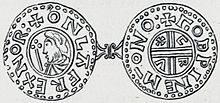
Back أولاف تريغفاسون Arabic اولاف تريجفاسون ARZ بیرینجی اف (نوروژ) AZB Олаф I Тругвасан Byelorussian Олаф I Bulgarian Olaf I, kralj Norveške BS Olaf Tryggvason Catalan Olaf I. Tryggvason Czech Olav Tryggvason Danish Olav I. Tryggvason German
| Olaf Tryggvason | |
|---|---|
 Only known type of coin of Olaf Tryggvason, in four known specimens. Imitation of the Crux-type coin of Æthelred the Unready.[1] | |
| King of Norway | |
| Reign | 995–1000 |
| Predecessor | Harald Bluetooth (as king) Haakon Sigurdsson (as regent) |
| Successor | Sweyn Forkbeard |
| Born | 960s Norway |
| Died | 9 September 1000 Svolder, Norway |
| Spouses |
|
| Issue | Tryggvi the Pretender (possibly) |
| Father | Tryggve Olafsson |
| Mother | Astrid Eiriksdatter |
Olaf Tryggvason (960s – 9 September 1000) was King of Norway from 995 to 1000. He was the son of Tryggvi Olafsson, king of Viken (Vingulmark, and Rånrike), and, according to later sagas, the great-grandson of Harald Fairhair, first King of Norway. He is numbered as Olaf I.
Olaf was important in the conversion of the Norse to Christianity, but he did so forcibly within his own kingdom.[2][3][4][5][6] He is said to have built the first Christian church in Norway in 995, and to have founded the city of Trondheim in 997. A statue dedicated to him is located in the city's central plaza.
Historical information on Olaf is sparse. He is mentioned in some contemporary English sources,[7] and some skaldic poems. The oldest narrative source mentioning him briefly is Adam of Bremen's Gesta Hammaburgensis ecclesiae pontificum of circa 1070.
In the 1190s, two Latin versions of "Óláfs saga Tryggvasonar" were written in Iceland, by Oddr Snorrason and Gunnlaugr Leifsson – these are now lost, but are thought to form the basis of later Norse versions. Snorri Sturluson gives an extensive account of Olaf in the Heimskringla saga of circa 1230, using Oddr Snorrason's saga as his primary source. Modern historians do not assume that these late sources are accurate, and their credibility is debated.[8] The most detailed account is named Óláfs saga Tryggvasonar en mesta ("Greatest Saga of Óláfr Tryggvason") and is recorded in the Flateyjarbók, and in the early 15th-century Bergsbók.
- ^ Skaare, Kolbjørn (1995). Norges mynthistorie. Universitetsforlaget. pp. 38–41.
- ^ "Saint Olav – King of Norway – VII. Olav and the work of Christianisation". Archived from the original on 5 February 2010. Retrieved 9 February 2011.
- ^ "404 Error". www.shadowdrake.com. Archived from the original on 9 July 2011. Retrieved 9 February 2011.
{{cite web}}: Cite uses generic title (help) - ^ Heimskringla, King Olaf Trygvason's Saga, section 52
- ^ "Olaf Tryggvason". Britannica. Archived from the original on 29 June 2023. Retrieved 17 August 2023.
- ^ Cite error: The named reference
:2was invoked but never defined (see the help page). - ^ E. g. Diplomatarium Norvegicum XIX, nr. 1 Archived 26 March 2019 at the Wayback Machine
- ^ Sverre Bagge, Helgen, helt og statsbygger – Olav Tryggvason i norsk historieskrivning gjennom 700 år, in Steinar Supphellen (ed.), Kongsmenn og Krossmenn – Festskrift til Grethe Authén Blom (Trondheim, 1992)